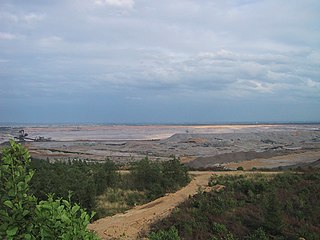
Lignite, often referred to as brown coal, is a soft, brown, combustible, sedimentary rock formed from naturally compressed peat. It has a carbon content around 25–35%, and is considered the lowest rank of coal due to its relatively low heat content. When removed from the ground, it contains a very high amount of moisture which partially explains its low carbon content. Lignite is mined all around the world and is used almost exclusively as a fuel for steam-electric power generation.

Kutch district, officially spelled Kachchh, is a district of Gujarat state in western India, with its headquarters (capital) at Bhuj. Covering an area of 45,674 km2, it is the largest district of India. The area of Kutch is larger than the entire area of other Indian states like Haryana (44,212 km2) and Kerala (38,863 km2). The population of Kutch is about 2,092,371. It has 10 talukas, 939 villages and 6 municipalities. The Kutch district is home to the Kutchi people who speak the Kutchi language.

NLC India Limited (NLC) is a central public sector undertaking under the administrative control of the Ministry of Coal, Government of India. It annually produces about 30 million tonnes of lignite from opencast mines at Neyveli in the state of Tamil Nadu in southern India and at Barsingsar in Bikaner district of Rajasthan state. The lignite is used at pithead thermal power stations of 3640 MW installed capacity to produce electricity. Its joint venture has a 1000 MW thermal power station using coal. Lately, it has diversified into renewable energy production and installed 1404 MW solar power plant to produce electricity from photovoltaic (PV) cells and 51 MW electricity from windmills.

Hub Power Company Limited, colloquially known as HUBCO, is the first and largest pakistan Independent Power Producer (IPP) with a combined installed power generation capacity of 3250 MW.
Solid Energy was the largest coal mining company in New Zealand and is a state owned enterprise of the New Zealand Government.
According to the United States Energy Information Administration (EIA), Pakistan may have over 9 billion barrels (1.4×109 cubic metres) of petroleum oil and 105 trillion cubic feet (3.0 trillion cubic metres) in natural gas (including shale gas) reserves.
Tarkeshwar also spelt "Tadkeshwar", is a town located in the Surat district, Gujarat, India, situated approximately 36 km (22 mi) away from Surat and on the Kim-Mandvi Road north of the Tapti River. It belongs to the Mandavi Taluka of Surat Panchayat, and is very close to Bharuch District. It has a population of about 15,000 people, with a slight majority of Vohra Gujarati Muslims and the remainder Hindus of various castes, including a number of Tribal Hindus. Most of the families are engaged in agriculture.

The Tagebau Hambach is a large open-pit coal mine in Niederzier and Elsdorf, North Rhine–Westphalia, Germany. It is operated by RWE and used for mining lignite.

Giral Lignite Power Plant (GLPL) or Giral Lignite Thermal Power Station (GLTPP) is a wholly owned subsidiary of Rajasthan Rajya Vidyut Utpadan Nigam Limited (RRVUNL). RRVUNL is a state government owned corporation working in field of power generation.
Kutch Lignite Thermal Power Station is Gujarat State Electricity Corporation Limited's only lignite based power plant.

Mata no Madh is a village in Lakhpat Taluka of Kutch district, Gujarat, India. The village lies surrounded by hills on both banks of a small stream and has a temple dedicated to Ashapura Mata, the household deity of former Jadeja rulers of kutch State. She is also considered patron deity of Kutch. The village is located about 105 km from Bhuj, the headquarters of Kutch district.
Shyamji Krishna Varma Nagar also known as S. K. VarmaNagar and commonly known as VarmaNagar is a City of India, developed in the 1970s, which is located in the Lakhpat Taluka of Kutch District of Gujarat. It is named after famous freedom fighter from Kutch, Shyamji Krishna Varma.

Gujarat Mineral Development Corporation Limited (GMDC) is a major Indian state-owned minerals and lignite mining company based in Ahmedabad. GMDC was founded in 1963.
Eobarbourula delfinoi is an extinct toad which existed in what is now Gujarat, India, during the Middle Ypresian age of the early Eocene. It was described by Annelise Folie, Rajendra S. Rana, Kenneth D. Rose, Ashok Sahni, Kishor Kumar, Lachham Singh and Thierry Smith in 2012, and is the only species in the genus Eobarbourula. The name of the genus is a combination of "Eo", referring to the epoch in which the animal existed, and Barbourula, the generic name of the jungle toads, while the specific epithet refers to Massimo Delfino, an Italian paleontologist.
Marcgodinotius is a genus of adapiform primate that lived in Asia during the early Eocene. It is a monotypic genus, the only species being Marcgodinotius indicus. Another adapiform primate Suratius robustus was found in the same horizon. Anthrasimias may be a junior synonym of Marcgodinotius and Anthrasimias gujaratensis a junior synonym of Marcgodinotius indicus.
Indiagama is an extinct genus of agamid lizard known from the type species Indiagama gujarata from the early Eocene of India. Indiagama was named in 2013 on the basis of a single lower jaw from the Cambay Shale in Gujarat. The rectangular shape of its teeth distinguish it from all other agamids, living and extinct.
Suratagama is an extinct genus of agamid lizard known from the type species Suratagama neeraae from the early Eocene of India. It was named in 2013 on the basis of three isolated jaw bones from the Cambay Shale in Gujarat.
Heterodontagama is an extinct genus of iguanian lizard from the Early Eocene of India. It belongs to the extinct family Priscagamidae, which is otherwise only known from the Late Cretaceous of Mongolia. The type species Heterodontagama borsukae was named in 2013 from several isolated upper and lower jaws found in an exposure of the Cambay Shale in an open-pit coal mine in Gujarat.
Vastan Mines are lignite and limestone mines in Gujarat state of India. They are under administration of Gujarat Industries power company limited (GIPCL) Scientists have discovered bat fossils there
Cambaytheriidae is a family of primitive four or five-toed ungulates native to the Indian subcontinent. They lived during the Early Eocene epoch and are distinguished by the presence of bunodont teeth suitable for eating tough vegetation. They are related to, but distinct from, the early perissodactyls, and may also be closely related to the anthracobunids as a sister group to the Perissodactyla.










